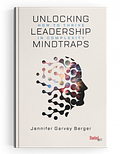My apologies dear friends for skipping the last edition - life has been a little bit “complex” recently - in theme with this week’s newsletter :). I’m happy to be back now; I chose a book from a thought leader I love reading, following, and seeing in action in inspiring workshops, and whose work focuses on leading successfully through complexity.
What genre? self-leadership, personal growth, leadership of others
Why read? in our highly interconnected, unpredictable, fast-changing, and complex world, and with reflexes that are not always helping, Jennifer Garvey Berger explores ways to make increased complexity our friend. She describes 5 mindtraps (i.e., cognitive and emotional shortcuts automatically used which can lead us in the wrong direction), and offers ways to unlock and solve them, for better decision-making and increased wellbeing in our life and in our work.
3 concepts that inspired me:
Change your relationship with “being wrong”, and adapt the way you listen to others: Instead of trying to be right or to fix something, ask yourself in what ways you could be wrong. Just because it feels right, it doesn’t mean it is right. Our sense of being right is an emotion like others - in fact, our brains have evolved to trick us that it is a thought or a reasoning process, but it is not, it is just an emotion. And whenever we find reasons to prove that we were right about something, it is often post-decision justification. We might have needed our sense of rightness for survival, however today it is hurting our curiosity and creativity. Let’s constantly challenge our beliefs, and treat being wrong as productive as being right - this will only make us better humans. As Kathryn Schultz put it “We are wrong about what it means to be wrong. Far from being a sign of intellectual inferiority, the capacity to err is crucial to human cognition. Far from being a moral flaw, it is inextricable from some of our most humane and honorable qualities: empathy, optimism, imagination, conviction, and courage (…)”
Try to imagine multiple stories on what is happening around you vs automatically believing one (especially when it’s hurting you): We humans love simple stories, and have used them to bring together tribes, religions, societies. We like to make the past simple in our mind (even when it wasn’t so clean or heroic), and we like to project a simplistic future. We like to create a beginning, middle and end, to connect cause and effects, and to identify heroes and villains. And for that, our brains fill the missing pieces with data we invent (refer to not making assumptions - in my previous newsletter). Creating these simple stories feels like it frees us from anxiety. However, the stories that we are telling ourselves are often not a true representation of the reality and will lead us to less-than-ideal decision making and often increased anxiety. Though it may be hard to stop creating simple stories in our minds, we should at least remember they’re just “simple stories” we’ve made up, believe in them less, and think of additional stories we may want to consider.
Look at conflicts as a way to deepen relationships and at disagreements as a way to come up with better ideas and possibilities: Today, we avoid disagreements/conflicts as we fear rejection and believe that agreement will lead to a sense of connection. It also literally feels good to agree as the brain releases dopamine when we agree with others. However, longing for agreement becomes counter-productive as it doesn’t expand our solution space and robs us of good ideas, since we withhold contradictory information that is necessary to find good solutions. We need diversity of experiences, approaches, and ideas to lead to better decisions in our life and our work. Let’s be okay with, and express disagreeing with others as a way to make our relationships stronger and our joint ideation better.
2 excerpts I enjoyed reading:
On finding your purpose:
“Each day, see if you can find at least one moment where your deep gladness and the world’s hunger meet, and jot down what that might look like on a plaque. Even if these are tiny moments - ‘Made a child laugh’ or ‘Eased the load for a colleague by helping her solve a problem’ - these are the seeds of your purpose. Collect them, and the shape and colors of the evolving garden will bloom”
On using your emotions as guidance and regulation:
“As you notice a strong emotion, imagine that it is braided together by many different colors of emotions. See if you can begin to just unpick the braid, laying out the colors alongside one another. Anger over negative feedback might unbraid into shame, indignation, gratitude, and the seeds of connection and change. It will help you deal better with each of your emotions (particularly the darker ones) if you can see all the shades that have created it. Unbraiding these emotions and allowing them to simply be will let you climb out of the simple stories, let go of your need for control, and generally find your way out of the mindtraps”
1 question I’m asking myself:
What is one difficult emotion I have been feeling or am feeling right now, and how can I unbraid it in different colors of emotions, to better help me deal with it?
With love, Vanessa




Loved this post! Sounds like a great book ❤️
Loved it! Especially the part about unpicking the braid. Even if just a little, it's super helpful to understand there's a bunch of colors in there :)